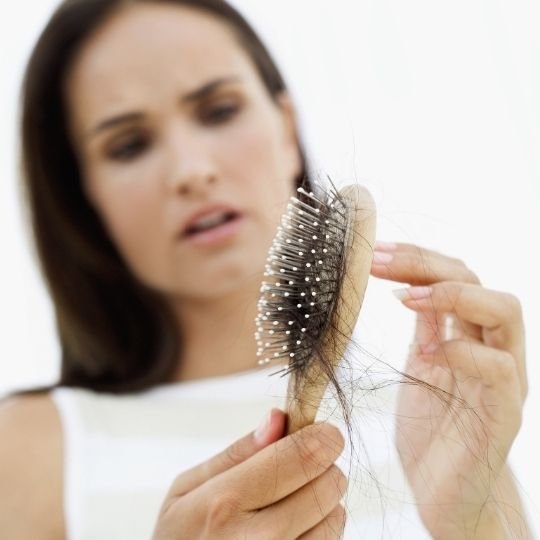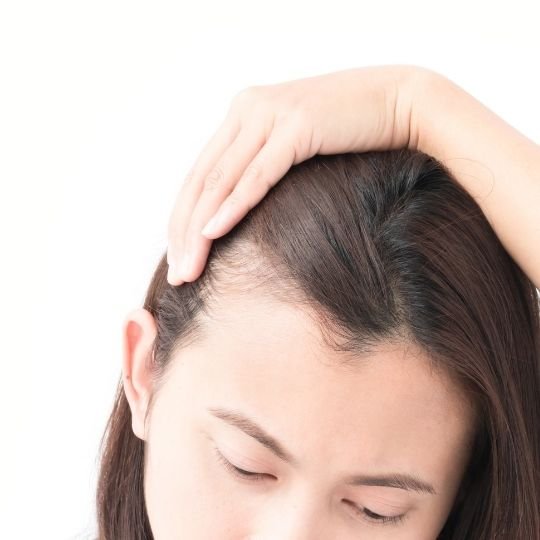Are You a New Mother and Your Hair is Falling Out?
Hair loss effects many women somewhere around 2-3 months after giving birth. Suddenly, your hair may start to fall out in what may seem to be alarming amounts.
Don’t panic, hair loss is a common postpartum symptom. In fact, dermatologists (aad.org/new-moms) refer to it as hair shedding, inferring that it is not a permanent state, which is different to hair loss (meaning more permanent hair loss).
Your hair is now going through a resting phase. It is perfectly natural to experience increased hair loss postpartum. Ask other new mums.
You will most likely notice what seems like excessive hair loss after taking a shower; the plughole may be blocked or more full with hair than you have ever seen before.
Your hair will be falling out all over your clothes and all over your house. On the furniture, floor, car seats, all over baby and even in your food (after dropping out whilst you are cooking).

The Amount of Hair Shedding will Vary from Woman to Woman
It depends on hormonal levels and how each body reacts to the changes in hormone levels.
According to the American Pregnancy Association 40-50% of women will experience increased hair loss postpartum.
What Causes Hair Loss After Giving Birth?
Hair growth and hair loss always happens in regular growth cycles. However, during pregnancy, these regular growth cycles change.
Remember that wonderful pregnancy glow you had? Your hair never looked better? You can put it down to hormonal changes and the extra hormone levels in your body which stimulate hair growth. Hormonal changes (increased estrogen levels) during pregnancy cause an increase in hair growth.
Normal Hair Growth Cycles
- 3-5 years growth (Anagen Phase)
- Short 10 day transition phase (Catagen Phase)
- 3 months resting phase (Telogen Phase) – when hair naturally falls out
- Normally, 85% of hair is in the growth phase
- and 15% is in the resting phase – that means an average person is always experiencing around 15% hair loss
- A greater increase in hair growth during pregnancy means a greater increase in hair entering the resting phase postpartum, when the pregnancy hormone levels have eased off. The amount of hair in the resting phase and consequent hair shedding can vary from woman to woman
- Hair in the resting phase is replaced by regrowth, which are new hairs forcing the resting hair to fall out (hair loss).

Does Postpartum Hair Loss Grow Back?
According to Bauman Medical an average human has 100,000 hair follicles on their head (it varies slightly depending on your hair colour). The average amount of daily hair loss varies between 50 – 100 hairs according to the American Academy of Dermatology Association (https://www.aad.org/). It will be more noticeable if you have longer hair or thinner hair.
The regrowth of your hair after it drops out postpartum:
- Hair loss occurs within a space of a few months postpartum
- Eventually the hair loss phase and process will calm down
- This means that regrowth will happen at the same time, leaving you with hairfuzz for a good few months, most likely for a year or more, until your hair lengthens.
- Hair grows around 0.3 to 0.4 mm per day or up to 1.25 cm a month (info from https://www.webmd.com)
If you think your hair loss is abnormal – perhaps more than a clogged up plughole – then consult your doctor to ensure that you don’t have an iron deficiency or thyroid disorder.
Tips for Postpartum Hair Care
- The “mum cut”- cut it shorter, especially towards the front, to disguise regrowth better. Many women have a baby fringe (or baby bangs) at the front of their hairline– cutting shorter and over the face is preferred by celebrities (see this Cosmopolitan article)
- Check the labelling on your shampoos and conditioners
- Avoid conditioning shampoos and intensive conditioners – these products can weigh down your hair, thus increasing hair shedding (advised by the American Academy of Dermatology)
- Brush or comb your hair gently, avoid pulling or tugging it as this will pull more out of already loose hair follicles
- Maintain a healthy diet; eat lots of fruit and veggies. Nourish yourself with proteins, irons and vitamin C*2
- Opt for a volumising shampoo to help to boost thinning hair
- Use a scalp treatment to reanimate your hair follicles and support healthy re-growth
- Take daily hair loss vitamins specifically for hair growth
- Make sure you buy a hair catcher for your shower and/or bathtub to catch any excess hair. As you could be shedding hair in a short period of time, your drains could get easily blocked if you don’t catch the hair
